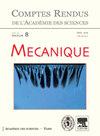Analyzing orthogonal cutting process using SPH method by kinematic cutting tool
IF 1
4区 工程技术
Q4 MECHANICS
引用次数: 1
Abstract
In this paper, the orthogonal cutting process is studied using Smooth Particle Hydrodynamic (SPH) method by a kinematic rigid cutting tool and two work-piece material models: perfectly elastic-plastic (EPP) model and Johnson–Cook (JC) model. The kinematic tool means that if the cutting tool is assumed a rigid body then the horizontal component speed of work-piece particles at cutting tool region are modified to the cutting speed. The chip shapes of orthogonal cutting process using SPH method with kinematic and kinetic tool models are compared with the experimental results. The chip obtained by the simulation with kinematic tool is more similar to the experimental results. Von-Mises stress distribution at different states of the orthogonal cutting process is investigated. The maximum stress occurs at the shear plane and causes the formation of chip teeth. Comparisons between chips of work-pieces with two material models are investigated including different rake angles of 5, 10 and 17.5◦ with feed rates of 0.3 and 0.4 mm/rev and the cutting forces of the process are obtained. The cutting force of process with 17.5◦ rake angle, 0.4 mm/rev feed rate and 800 m/min cutting speed is validated using experimental result.利用SPH方法分析了运动学刀具的正交切削过程
本文采用光滑颗粒流体动力学(SPH)方法,采用运动刚性刀具和完全弹塑性(EPP)模型和Johnson-Cook (JC)模型两种工件材料模型,对正交切削过程进行了研究。刀具运动是指假设刀具为刚体时,将工件颗粒在刀具区域的水平分量速度修正为切削速度。采用SPH方法,结合刀具运动学模型和动力学模型,对正交切削过程的切屑形状与实验结果进行了比较。用运动学工具仿真得到的芯片与实验结果更接近。研究了正交切削过程中不同状态下的Von-Mises应力分布。最大应力发生在剪切面,导致切屑齿的形成。对前倾角为5、10和17.5◦、进给速度分别为0.3和0.4 mm/rev的两种材料模型下的工件切屑进行了比较,得到了加工过程的切削力。实验结果验证了17.5◦前倾角、0.4 mm/rev进给速率、800 m/min切削速度下的切削力。
本文章由计算机程序翻译,如有差异,请以英文原文为准。
求助全文
约1分钟内获得全文
求助全文
来源期刊

Comptes Rendus Mecanique
物理-力学
CiteScore
1.40
自引率
0.00%
发文量
0
审稿时长
12 months
期刊介绍:
The Comptes rendus - Mécanique cover all fields of the discipline: Logic, Combinatorics, Number Theory, Group Theory, Mathematical Analysis, (Partial) Differential Equations, Geometry, Topology, Dynamical systems, Mathematical Physics, Mathematical Problems in Mechanics, Signal Theory, Mathematical Economics, …
The journal publishes original and high-quality research articles. These can be in either in English or in French, with an abstract in both languages. An abridged version of the main text in the second language may also be included.
 求助内容:
求助内容: 应助结果提醒方式:
应助结果提醒方式:


